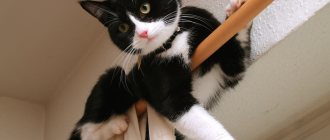The domesticated Serval is an extremely interesting and entertaining breed. These graceful creatures are one of the few cat families that belong to the wild. This explains their magnificent exotic color, non-standard habits and character traits.
They cannot be compared with ordinary cats, since servals require significant financial and time investments, careful study of the characteristics of the breed and a fairly serious approach.
Their owners are people with an exceptional love for cats and a desire to make friends with a reliable pet, which is quite capable of not only giving love to the owner, but also, if necessary, even protecting from danger.
The only thing is that when choosing a kitten, you need to contact trusted breeders and not skimp on your future furry friend.
Origin story
The serval is very similar in appearance to the cheetah, this is its main feature and unusualness. By and large, this is true. It seems as if he simply decided to temporarily accompany a wealthy owner and decorate a large mansion with himself.
The serval is native to Africa. The cat's valuable fur has always attracted the attention of poachers. Therefore, from year to year their numbers are rapidly declining, despite the initially impressive population size.
Today you can count more than 14 varieties of wild servals, differing in their color. Domestic servals began to appear when a certain group of people discovered that this type of animal was well tamed. Breeders began to take advantage of this, thereby obtaining incredible pets.
Description of the Serval breed
This proud representative of the African continent is a true predator. All these features are clearly manifested in his appearance. There are no specific unified breed standards, but some distinctive features are created by nature itself:
- They are characterized by a small head size and large, high-set ears relative to the entire body. They are colored with white and black stripes on the outside.
- The area of the bridge of the nose is quite wide.
- The eyes are almond-shaped along the lower edge, and their upper part resembles a boomerang.
- The head has long whiskers of a dense structure with pronounced pads.
- The total body length is small compared to other African animals. But relative to ordinary domestic cats, they are simply huge. The length from head to tail can reach 1 meter.
- The tail is from 25 to 40 cm.
- Servals have the longest limbs among all cats (relative to the rest of the body). Also, their hind legs are longer than their front legs.
- Weight can range from 8 to 18 kilograms.
- The color of the coat is very similar to the skin of a cheetah. The coat is covered with beautiful spots. They are located over the entire surface of the animal’s body, uniting on the back into long stripes. The muzzle, chest and belly are most often light in color. The overall tone of the fur varies from yellow-sand to brown-red. It is thick, tender and soft.
Origin and popularity
Servals were not immediately tamed and domesticated, and today these amazing creatures live in the wild. Egypt in particular, and a significant part of the African continent as a whole, can safely be considered their homeland.
In ancient Egypt, cats were always revered, but servals were very popular because of their hunting talents - where these bush cats appeared, snakes and rodents immediately disappeared. This is confirmed by many figurines and drawings with images of this cat found by archaeologists. Previously, they lived throughout Africa, and now they live mainly in the southern part of the continent (the largest number is in Tanzania).
The first mention of servals dates back to 1765. Then the famous Count Georges-Louis Leclerc described a large golden cat with distinct spots and stripes, which was a pet of the Royal Menagerie of Versailles.
The Serval breed got its name from the Portuguese name, but the nickname “bush” cat is due to its place of residence, since the animals try to hide in tall bushes. This helps to hide from larger predators and easily sneak up on prey.
If we talk about the domesticated serval, as it is known now, the breed was registered in the middle of the 19th century. They were owned exclusively by wealthy families throughout Europe, because they were a sign of high taste and even luxury.
It is difficult to distinguish wild animals from domestic ones by external signs; this is where habits come into play.
Temperament
Servals are primarily wild predators with their own character. In home conditions, you should carefully approach the issues of its manifestation. These beauties simply love to run and frolic, so do not interfere with this.
In nature, it is common for them to hunt birds. When jumping, they can reach a height of up to three meters. Therefore, you should be prepared for the fact that at home they will conquer all the heights available to them. Ensure that certain fragile or valuable items are kept away from areas where your pet is most likely to be.
This breed is generally quite friendly and curious. They explore their territory with great interest and protect it well. Many owners of these animals write that these cats are a little like dogs.
History of the breed
Servals are native to Africa. They are more common in sub-Saharan countries. Bushes and tall grass help these “mini cheetahs” hunt. Animals prefer solitude. One individual “knocks out” a territory of 10-30 square meters. km. Servals have lived with people since the times of the ancient Egyptians. But it was not possible to completely domesticate the breed.
Animals were brought to the USA for breeding about 100 years ago. Servals appeared in Europe around the beginning of the 20th century.
Health
At a young age, kittens should not be allowed to jump from high surfaces. Their limbs are very fragile during this period, so the risk of injury increases.
It is also necessary to monitor the animal's stool. If your pet experiences diarrhea more than twice a day, you should immediately contact your veterinarian. Cats of this breed require timely vaccination. IMPORTANT! Vaccinations must be done using inactivated drugs. Because the life of the animal depends on it!
Servals are also distinguished by the fact that they can mark their territory about 50 times a day. The process is accompanied by a very unpleasant odor. Therefore, the best solution in this case is castration. It is better to sterilize cats no older than one year, and cats should be subjected to the procedure as early as 8 months.
Life expectancy at home is higher than in the natural habitat. On average it is 15-20 years.
Home Serval
Servals are the only cats whose ancestors belong to the wild and which, without exception, can become very affectionate pets if they are purchased as babies from professional breeders specifically for domestic Servals, and not wild ones. They are ideal for keeping in a country house or large apartment. The domestic Serval is often considered a symbol of prestige and high status of its owner. Servals are one of the most impressive, shocking and truly exotic pets.
It is precisely because of the similarity in character and habits with domestic dogs that Servals are gaining more and more popularity all over the world every year. After all, who doesn’t want to have a pet as loyal as a dog, but at the same time with cat-like grace and a real exotic color?! Almost without exception, people are surprised when they see how a “mini-cheetah” brings a thrown ball to its owner or walks with him on a leash in an elite village, so our clients often jokingly call Servals “a real cat-dog.” The Serval is more than just a pet, it can also highlight your lifestyle due to its exotic coloring and availability only to people with high incomes. One of our clients even takes his Serval to business meetings to add a special atmosphere to business negotiations.
For lovers of domestic cats, Servals are the ultimate choice from the entire cat family, they are smarter, more loyal and more active than ordinary domestic cats - a sort of “doggie cat”.
Dimensions
The Serval is a slender, long-legged, medium-sized cat. Its body length is 65-100 cm, plus a relatively short tail - 25-40 cm, height at the withers up to 60 cm; weight up to 16 kg. The serval has the tallest legs and largest ears (relative to body size) among cats. His head is miniature. Based on a number of morphological features, the Serval is considered a close relative of lynxes and caracals, although in color it most closely resembles a cheetah - dark spots and stripes on a yellowish-gray background. His chest, belly and muzzle are white. The ears are black on the outside with yellow or white transverse spots.
The life expectancy of a Serval in the wild is 10-12 years, at home 15-20 years - this is a friend for a long time.
Origin
Servals are distributed throughout almost the entire territory of Africa, excluding the Sahara, forests of the equatorial zone and the extreme south of the mainland (Cape Province). North of the Sahara (Algeria, Morocco) this animal is now extremely rare, but is still quite common in East and West Africa. The largest population of serval cats is in the famous Ngoro Ngoro Crater (Tanzania), the density of cats there is up to 40 per 100 square kilometers.
Servals almost always live near water sources. Therefore, when keeping Serval at home, you should not forget about their love of water and promptly hide vases of flowers, as well as close the toilet lid. It is also better to keep going outside closed if the forecast predicts precipitation. Otherwise, your Serval will carry all the water throughout the house in a matter of minutes, evenly distributing the dirt over its favorite resting places.
Serval in your home
It is advisable to adopt a Serval kitten no earlier than 1.5 months of age, but no later than 5 months. The younger your kitten, the faster he will become attached to you. It is not necessary to take a kitten very young and bottle feed it in order to get a stronger bond between you. But it certainly enhances and facilitates that experience of connection.
Servals are very playful and athletic. In nature, they catch birds gliding low above the ground, making a vertical jump of up to 3 meters in height, so they are able to jump onto almost any surface in the house and love to sit on high places. All easily breakable items should be removed from shelves and tables in inaccessible places until the Serval gets comfortable in your home.
Like a domestic cat, the Serval marks its territory, so we recommend spaying/neutering the Serval, this will relieve you of the unpleasant and very strong odor. This procedure is performed for boys aged 7 to 8 months, for girls a year.
Be patient with your Serval - he needs time to get used to his new surroundings. Remember, if you take proper care of your Serval, he will bond with you like no other animal you have ever seen. Despite all the stories that cats are “on their own,” once you earn the affection of a Serval, you will receive such trust and such love that you will hardly believe that the Serval is a “wild” animal.
The myth of the danger of Servals
We want to devote special attention to this issue, dispelling the opinion that Servals are dangerous and wild animals. It is noteworthy that this myth is spread by people who have never had real contact with these pets at home. We understand that before it was difficult to find out the truth - we are not offended by the yellow press journalists, because this is their “job” and by people who do not have sufficient information about Servals.
Do not confuse aviary Servals (for breeding) with domestic ones, which grew up in constant communication with people. Let us tell you a little secret: if we played a lot with our adult enclosure Servals and entertained them in every possible way, we would not see such frequent offspring. They would be exclusively pets who, as usual, run after you and purr, asking to be thrown a ball, just to play or pet them.
In short, purchasing a Serval is no more dangerous than purchasing a medium-sized dog.
In more detail:
— Servals in the wild hunt rodents and small birds; humans are an insurmountable rival for them, so when they are scared, the most they do is hiss.
— When faced with a direct threat, even in nature, they run away and very rarely go on the attack; for example, the protection of small kittens by an adult Serval mother may be an exception.
Stepping away from the wild:
— Servals are very afraid of “flayer children” who stretch their ears, pull their paws, tail, painfully grab their fur and at the same time scream or squeal very loudly, beat them, chase them, deliberately plop down on the Servals - but you must agree that this is not Any pet will like it, even a simple cat or dog. Undoubtedly, if in these cases the Serval is squeezed, he may scratch or bite in order to escape from terror, therefore it is not recommended to keep the Serval in a house with children under 5 years old, it is from this age, as a rule, that children can already understand how not to handle the pet. Otherwise, Serval will be afraid of them, and may never get rid of this fear. Servals are very smart and are able to distinguish a child's voice from an adult's and thus hide from children.
But if the child is brought up and knows how to handle animals, understanding that they also experience pain, then this will be a guarantee of peace and harmony in your family.
— It is extremely important to remember three golden rules in raising Servals:
1. Do not play the game of “fighting with an arm or a leg” with a kitten - it is better to use his toys for this, otherwise, as he grows up, he will perceive your arms and legs as his toys, scratching and biting them.
2. Do not shout or hit the Serval - for example, if your Serval constantly climbs onto the dining table, and you do not like it, then “arm yourself” with a water pistol or a flower sprayer. Clearly saying the command “no!” and by sprinkling water on it, your Serval will very quickly learn the lesson and in other situations just one command “no” will be enough!
3. If the Serval is flirting with scratching you, then just leave him alone in the room at this moment, believe me, he will very soon realize that he is doing something wrong, since he is left alone. Servals are extremely intelligent and require basic training, just like dogs.
— Servals get very used to those who raise him, and if guests (third parties) rarely appear in the house, then most likely he will run and hide when they arrive.
— It is important that all family members pay attention to the Serval as much as possible. You are his parents (his flock) in which he feels safe and responds for this with gratitude and affection, rubbing his head against you with his ears, while purring sweetly.
Perhaps these are the most important points, if it is difficult for you to fulfill them, then you should not buy such a pet, and if for you these are things that go without saying and you are ready to give your love and time to your pet, then you will have an amazing and more devoted than dog, friend!
Near other pets
Servals play friendly with most other pets. However, an adult Serval should be introduced to small animals carefully, as he may mistake them for a toy and injure them. Remember that their natural food includes hamsters, guinea pigs, birds, small reptiles, etc., so it is best not to keep them indoors. The Serval has very strong natural instincts for these animals, and he is very persistent and inventive - the Serval can even open door latches if he smells a bird, so it is better not to tempt him.
What about dogs? It depends on the dog! If you have a patient, gentle, decent-sized dog that doesn't chase cats, you're on the right track and you won't have any problems.
The Serval will get along better with other pets if it is brought into the house as a very young kitten.
Nutrition
The first step in creating a diet for your Serval is to research what they eat in the wild. Studies of droppings in the Camberg Nature Reserve have shown that the food of Servals in this area consists of 80% rodents, 13.5% shrews, 5% birds, 0.9% reptiles and 0.7% insects.
The Serval diet at home is much simpler, which does not cause unnecessary difficulties for the owner, it consists of raw meat with bones - poultry and beef (for example, chicken or quail thighs, wings, hearts, necks) and special vitamins with calcium supplements, some of the best Apperon (USA) is considered in the world.
Adult Servals eat between 0.45 and 1.36 kg of meat per day.
Character
The best way to gain the respect of a Serval is to hand feed it from childhood. This way, the Serval will know that your presence is safe for him.
Another way is to lie down next to him on the floor and play with him. This way, the Serval won't feel overwhelmed by your downward gaze. When you are at the same eye level with him, he is more likely to get used to you, and will soon feel comfortable around you, regardless of whether you are standing, sitting or lying down.
Servals love to hang on hanging ropes, cords and wires. It is imperative to protect them, as the Serval can become entangled and accidentally injure itself or even suffocate.
The Serval kitten loves to chew everything, in this regard he looks like a puppy. Therefore, it is best to have a lot of toys for him to divert his attention from the things that are important to you. If your Serval is chewing on things that are not intended for this purpose, especially any electrical wires or electrical appliances, we recommend using an apple spray, which will repel the Serval's interest in this item. Similar sprays are sold in pet stores. Spraying can be repeated if necessary.
Remember, Servals should never be beaten, otherwise you risk losing his trust forever. You can give him a light spank or use a water gun, but in the vast majority of cases a verbal explanation, such as a firm "no" command, will be sufficient. Servals are very cunning and stubborn, so if you see that he is crossing the permitted boundaries, for example, biting too hard during play, just stop playing with them. When this situation is repeated several times, Serval himself realizes what exactly he is doing wrong.
Regular cat toys are suitable for small Servals, but as they grow, they must be replaced with larger dog toys to avoid inhalation.
If you want to accustom your Serval to a leash and collar, it is better to start doing this when he is still small. Give your Serval time to get used to the loose collar before you can tighten it. Never leave your Serval unattended with a leash attached to a collar; he could become entangled in it and be injured or strangled.
Servals are very dexterous and resourceful, so if he wants to break out, it will not be easy to cope with him. As a rule, he will break free if he senses danger from the outside; this does not mean at all that he wants to run away from you. Try not to scare the Serval so that he feels completely safe next to you.
Servals know how to climb trees, but they don’t like it. In nature, they seek shelter in the branches of acacias or baobabs only from wild dogs.
You will find games of tug not only among dogs. When it comes to their favorite toy, Servals may well start a competition with the neighbor's bulldog.
Servals love to play fetch and bring the balls they throw to their owner.
Toilet training
It is not difficult to train a Serval to use litter; we recommend wood litter. They usually do not litter the litter box like house cats.
If your Serval went to the toilet in the wrong place, you should not scold him; it is enough to explain this to him verbally, showing him the correct place. In nature, the Serval has one or two places for a toilet in its territory, which is why sooner or later the Serval will become accustomed to its toilet in your home. We recommend using Natural Miracle enzyme-based odor control products if your Serval has gone to the toilet in the wrong place. For kittens, regular cat litter boxes are suitable; for adult Servals, it is better to use a tray measuring 60 by 100 cm. Keep the litter box clean.
Health
Servals require vaccinations, the same as domestic cats. However, make sure that the vaccine does not contain active viruses. Otherwise, the animal may get sick and die. It is very important.
Your Serval cannot explain to you what is hurting him, so if you notice any strange behavior or movement, contact your veterinarian immediately.
Diarrhea in particular is something to watch out for, it leads to dehydration and can completely dehydrate a young cat in just a couple of hours. In such a case, Serval requires intravenous treatment. If you notice signs of diarrhea (loose stools) in your Serval more than twice in a row, you should contact your veterinarian. Diarrhea is treated quickly and easily and can sometimes be caused by a change in food, as in other cats.
You should also monitor your Serval when he is still a kitten so that he does not climb or jump from high objects, as his legs grow very quickly and they are quite fragile during this period.
Take care of your kitten, you are his parents, give him your affection and care, and he will respond in kind.
The L'UNICORNE company is the only one in Russia that has a centralized nursery in Russia for domestic Servals, with the necessary specialists, food and vitamins, as well as consultants from the USA and Scotland.
Care and maintenance
Raising a safe animal with a kind and easy-going character at home is possible, but you should follow a number of rules:
- The kitten should be hand fed. This way he will form pleasant associations with the owner, he will feel safe
- All play with a baby serval should be done on the floor. This will prevent him from seeing you as a threat.
Expert advice:
- Avoid playing with the owners' hands and feet.
- Don't raise your voice at your pet. The Serval responds well to voice commands. It is strictly forbidden to beat an animal; servals do not forgive this.
- The best punishment for bad behavior is being left alone. The animal is aware of its behavior and will definitely come to peace.
- It is easy to teach a kitten to the “no” command using a simple spray bottle, sprinkling water on it if the baby does something forbidden.
Where to buy a Serval kitten?
We were one of the first in Russia to start working with Servals brought from the USA, Canada, and the Czech Republic.
The recommended age for purchasing a pet of this breed is from 1.5 to 5 months. The younger the kitten is, the higher the likelihood of growing him into a loyal and devoted friend.
It is best to purchase an animal from a nursery where you can see its parents, from professional breeders with good recommendations.
On average, the cost of a kitten is 450-550 thousand rubles. You can find it cheaper, but there is no guarantee that you will get a socially adapted animal, and in the future it will turn out to be a well-mannered pet.
This is a very rare exotic cat not only in Russia, but throughout the world. Features of appearance, as well as nuances of maintenance, make servals cats of the highest segment.
Keeping a Serval at home is not a cheap pleasure. Such an acquisition will emphasize the high status and financial position of its owner.
What does the price depend on?
In Russia, a serval can be bought for varying amounts of money. The price is formed under the influence of a number of factors:
- Age of the kitten.
- Purebred.
- Place of purchase.
- Availability of pedigree.
- Coat color, intensity.
- State of health.
- Generation.
- Availability of a veterinary passport.
- Availability of a veterinary card.
Hybrids between a serval and a domestic cat are called Savannahs and are much cheaper than purebreds. Having a veterinary card or passport makes the purchase more expensive. The more intense the color of the animal, the higher its cost will be.
Five reasons to buy a kitten in our nursery
1. We almost always have kittens in stock that you can purchase;
2. Since they are all born in our nursery, we can offer lower prices;
3. If you wish, you can order a kitten for yourself from different manufacturers, having previously visited our nursery;
4. We keep grown cats of all breeds so that you can see what your pets will become in the future;
5. We do not try to deceive customers for the sake of sales at any cost.
Buy a Serval kitten
Approximate prices
In Russia you can buy a Serval kitten for approximately the following price:
- According to an advertisement submitted on the Internet - from 450,000 rubles .
- In a nursery, from a professional breeder - from 500,000 rubles .
A purebred kitten with a pedigree and all the necessary documents costs about 1,600,000 rubles . A hybrid brood is sold at a price of 630,000 rubles . If the animal costs less than 400,000 rubles, then it is better not to take it: most likely the seller is passing off another, less valuable breed as a serval.











